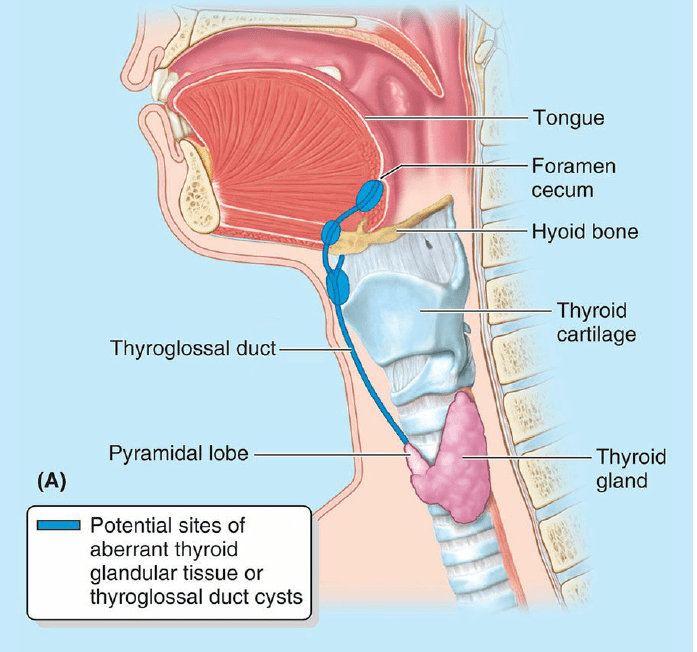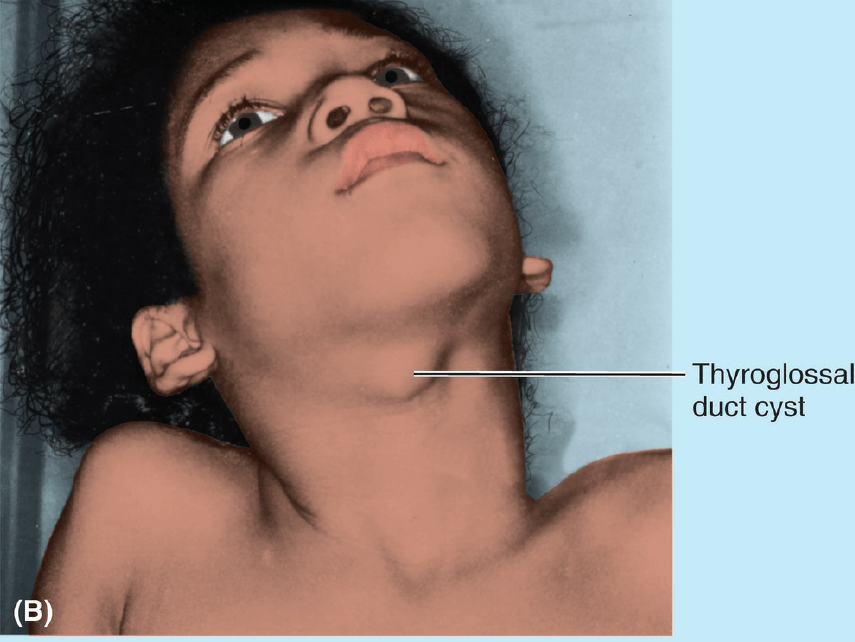Thyroglossal Cyst
content of this page
1- Introduction
2- Anatomical Overview
3- Causes
4- Treatment
Introduction
A thyroglossal cyst is a congenital fluid-filled sac that forms from remnants of the thyroglossal duct, which is a structure present during early embryonic development. This cyst typically appears in the midline of the neck, usually below the hyoid bone. It can present as a painless, smooth, and movable lump. Although often asymptomatic, it can sometimes become infected, causing pain and swelling.

Anatomical Overview
Development of the thyroid gland begins in the floor of the embryonic pharynx at the site indicated by a small pit, the foramen cecum, in the dorsum of the postnatal tongue. Subsequently, the developing gland relocates from the tongue into the neck, passing anterior to the hyoid and thyroid cartilages to reach its final position anterolateral to the superior part of the trachea. During this relocation, the thyroid gland is attached to the foramen cecum by the thyroglossal duct. This duct normally disappears, but remnants of epithelium may remain and form a thyroglossal duct cyst at any point along the path of its descent. The cyst is usually in the neck, close or just inferior to the hyoid, and forms a swelling in the anterior part of the neck. Surgical excision of the cyst may be necessary. Most thyroglossal duct cysts are in the neck, close or just inferior to the body of the hyoid.

Causes
Embryological Development: During fetal development, the thyroid gland begins at the base of the tongue and descends to its final position in the neck. As it moves, it leaves a tract called the thyroglossal duct. Normally, this duct disappears, but if portions of it remain, they can develop into a cyst.
Congenital: The presence of a thyroglossal cyst is congenital, meaning it is present at birth. However, the cyst may not become noticeable until later in childhood or adulthood when it becomes enlarged or infected.
Infections: Although not a direct cause, infections can exacerbate the condition. Upper respiratory infections can lead to inflammation of the cyst, causing it to swell and become painful.
Trauma: In some cases, trauma to the neck area can trigger symptoms or the appearance of a previously unnoticed thyroglossal cyst.
Treatment
Surgical Removal (Sistrunk Procedure):
- This is the most common and effective treatment. The procedure involves removing the cyst, a portion of the thyroglossal duct, and the central part of the hyoid bone to ensure complete removal and reduce the risk of recurrence.
Antibiotics:
- If the cyst becomes infected, antibiotics may be prescribed to treat the infection before surgery. This helps reduce inflammation and makes the surgical procedure safer and more effective.
Drainage:
- In cases where the cyst has formed an abscess, drainage may be necessary to relieve symptoms. However, this is usually a temporary measure, and surgical removal will still be needed to prevent recurrence.
Follow-up:
- Regular follow-up after surgery is important to monitor for any signs of recurrence or complications. Most patients recover well without significant issues.